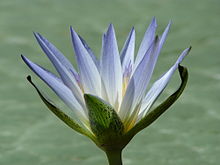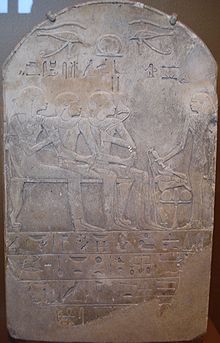- Nymphaea caerulea
-
Nymphaea caerulea Nymphaea caerulea flower Scientific classification Kingdom: Plantae (unranked): Angiosperms Order: Nymphaeales Family: Nymphaeaceae Genus: Nymphaea Species: N. caerulea Binomial name Nymphaea caerulea
Sav.[1]Nymphaea caerulea, also known as the Blue Egyptian water lily or sacred blue lily, is a water-lily in the genus Nymphaea.
Contents
Distribution
Its original habitat may have been along the Nile and other locations in East Africa. It spread to other locations, however, already in ancient times, like the Indian Subcontinent and Thailand.
Description
The leaves are broadly rounded, 25–40 cm across, with a notch at the leaf stem. The flowers are 10–15 cm in diameter.
Floral symbolism
Reports in the literature by persons unfamiliar with its actual growth and blooming cycle have suggested that the flowers open in the morning, rising to the surface of the water, then close and sink at dusk.[citation needed] In fact, the flower buds rise to the surface over a period of two to three days, and when ready, open at approximately 9–9:30 am and close about 3 pm. The flowers and buds do not rise above the water in the morning, nor do they submerge at night. The flowers have pale bluish-white to sky-blue or mauve petals, smoothly changing to a pale yellow in the centre of the flower.
It was considered extremely significant in Egyptian mythology, since it was said to rise and fall with the sun. Consequently, due to its colourings, it was identified, in some beliefs, as having been the original container, in a similar manner to an egg, of Atum, and in similar beliefs Ra, both solar deities. As such, its properties form the origin of the lotus variant of the Ogdoad cosmogeny. It was the symbol of the Egyptian deity Nefertem.[2]
Properties and uses
In modern culture, blue lotus flowers are used to make various concoctions including blue lotus tea, wine and martinis. Recipes for such drinks involve steeping or soaking the petals, about 10–20 grams for up to three weeks. Blue lotus 'tea' is prepared by boiling the entire flowers for 10–20 minutes.
Recent studies have shown Nymphaea caerulea to have mild psycho-active properties. It may have been used as a sacrament in ancient Egypt and certain ancient South American cultures. Eating Blue Lotus can act as a mild sedative. Nymphaea caerulea is distantly related to, and possesses similar activity to Nelumbo nucifera, the Sacred Lotus. Both Nymphaea caerulea and Nelumbo nucifera contain the alkaloids nuciferine and aporphine.[3] The mildly sedating effects of Nymphaea caerulea makes it a likely candidate (among several) for the lotus plant eaten by the mythical Lotophagi in Homer's Odyssey.
This lotus is used to produce perfumes since ancient times; it is also used in aromatherapy.
Used in aromatherapy, Nymphaea caerulea is purported to have a "divine" essence, bringing heightened awareness and tranquility.[citation needed] Some sources cite it as an antispasmodic similar to copal resin.
See also
- Nymphaea lotus, the Egyptian white water-lily
- Nymphaea nouchali, the star lotus
- Palmette
- Fleur-de-lis
- Sacred Weeds, a Channel 4 TV series examining the effects of various psychoactive plants (including the Blue lily) on volunteers
- Aporphine
References
- ^ "Nymphaea caerulea information from NPGS/GRIN". www.ars-grin.gov. http://www.ars-grin.gov/cgi-bin/npgs/html/taxon.pl?25433. Retrieved 2008-12-04.
- ^ Wilkinson, Richard H. (2003). The Complete Gods and Goddesses of Ancient Egypt. Thames & Hudson. ISBN 0-500-05120-8.
- ^ http://www.touregypt.net/featurestories/lotus.htm
Categories:- Entheogens
- Nymphaea
Wikimedia Foundation. 2010.


